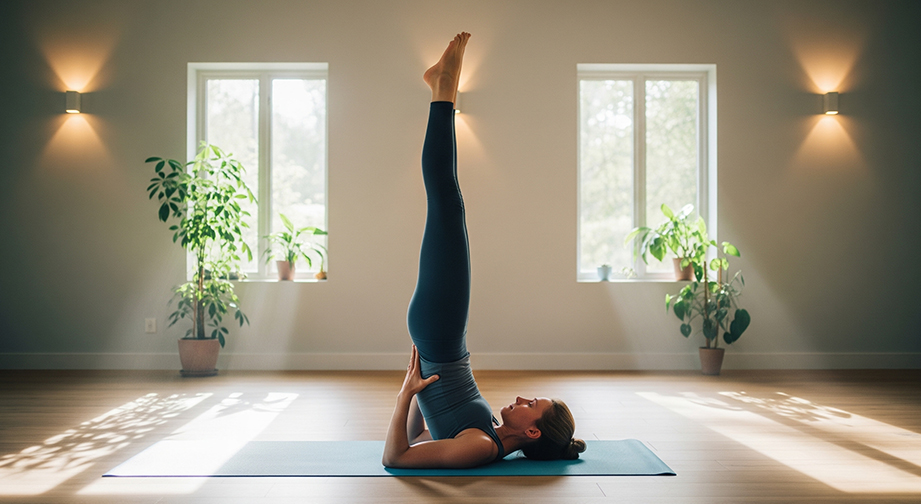Sarvangasana (Shoulder Stand): How to Practice Safely for Mind & Body Balance
Introduction
Sarvangasana, popularly known as Shoulder Stand, is a deeply rejuvenating yoga asana where the body comes “upside down,” supported on the shoulders. In Sanskrit, Sarva means “all” and Anga means “limb” — signifying this is the “all-limbs pose,” impacting the entire body.
Essence: Calming and balancing — Sarvangasana resets your system, much like pressing a gentle “refresh” button.
If you’ve ever felt sluggish, stiff, or just mentally overloaded after a long day, this pose can be your best friend in restoring energy and calm!
Step-by-Step Guide: How to Practice Sarvangasana (Shoulder Stand)

- Begin on Your Back
- Lie down on your yoga mat, arms at your sides, palms down. Relax and take a few breaths.
- Bring Your Knees to Your Chest
- Exhale as you gently draw your knees toward your chest, keeping your neck long and chin slightly tucked.
- Lift Your Hips Off the Floor
- Press your palms into the mat and lift your hips upwards, supporting your back with your hands. Inhale as you do this.
- Stack Your Legs Above Your Hips
- Walk your hands up your back towards your shoulder blades. Slowly straighten your legs up towards the ceiling (toes pointing up). Keep your elbows shoulder-width apart.
- Hold and Breathe
- Keep your gaze softly towards your chest or ceiling. Breathe deeply and steadily — inhale and exhale through your nose.
- To Release
- Exhale gently as you bend your knees back to your chest, slowly rolling your spine down to the mat, vertebra by vertebra.
- Duration: Start with 15–30 seconds. Over time, increase up to 3 minutes, depending on comfort.
- Rounds: 1-3 rounds with rest in between.
Modifications & Intensifications
- Beginner: Place a folded blanket or bolster under your shoulders for support, or do the pose with your legs up a wall (Viparita Karani).
- Advanced: Try variations like Niralamba Sarvangasana (unsupported), or move into Halasana (Plow Pose) as a follow-up.
Alignment & Safety Tips
- Alignment cues:
- Keep neck long & chin gently tucked (never turn the head).
- Elbows stay close, not splaying out.
- Body weight rests on upper arms & shoulders, never the neck or head.
- Common mistakes:
- Rolling onto your neck/head & compressing the cervical spine — avoid by continually lengthening the neck and supporting the back well.
- Letting elbows go wide — keep pressing upper arms into the ground.
- Safety precautions:
- Avoid Sarvangasana if you are pregnant, menstruating, have glaucoma, neck or spine injuries, uncontrolled thyroid, or high blood pressure.
Benefits of Sarvangasana (Shoulder Stand)
- Physical Benefits:
- Tones core, shoulders, and back
- Improves flexibility of neck and spine
- Boosts blood flow and circulation
- Supports hormonal balance through thyroid stimulation
- Helps improve posture
- Mental Benefits:
- Calms the mind, reduces stress and anxiety
- Develops inner focus and mindfulness
- Improves sleep and restfulness
- Energy/Chakra Connection:
- Stimulates ‘Vishuddha’ (Throat Chakra) — associated with communication, self-expression, and inner purification
- Balances energy flow throughout the body
Contraindications
- Should be avoided if you:
- Are pregnant or menstruating
- Have glaucoma, ear infections, or uncontrolled high blood pressure
- Experience neck, shoulder, or spinal injuries
- Have a heart condition or recent surgery
- Safe alternatives: Viparita Karani (Legs Up the Wall), Bridge Pose (Setu Bandhasana), or Supported Shoulder Stand with props
Beginner’s Tips & Variations
- Props: Use a folded blanket or bolster under shoulders for neck safety. A wall can help with balance.
- Gentle variations: Try Ardha Sarvangasana (keep knees bent); Legs Up the Wall for inversion benefits without full lift.
- Advanced: Progress to unsupported Shoulder Stand, or move into Halasana (Plow), Eka Pada Sarvangasana (one leg lowered), or Padma Sarvangasana (legs in Lotus).
How to Include Sarvangasana in Your Yoga Flow
- When? Best as a main posture or in the cool-down period of a session (after warming up the back/body).
- Pairs well with:
- Matsyasana (Fish Pose) — a counterpose
- Setu Bandhasana (Bridge Pose)
- Halasana (Plow Pose)
Mind-Body Connection
While holding Sarvangasana, cultivate mindfulness by gently focusing on your steady breath. Let thoughts drift away as you bring awareness to bodily sensations and the quiet energy within. Traditionally, this pose is said to support spiritual growth, activating the Vishuddha Chakra (throat energy center).
Summary Box
- Asana Name: Sarvangasana (Shoulder Stand)
- Level: Intermediate (with beginner modifications available)
- Focus Areas: Core, shoulders, neck, back
- Duration: 30 seconds to 3 minutes
- Best Time to Practice: Morning or evening (when well-warmed-up & calm)
Frequently Asked Questions about Sarvangasana (Shoulder Stand)
- Is Sarvangasana good for beginners? Yes, with modifications such as props or wall support; always listen to your body!
- How often can I practice? 2–3 times per week, allowing rest days for recovery.
- Why shouldn’t Sarvangasana be done during menstruation? Inversions may disrupt natural flows and increase discomfort during periods.